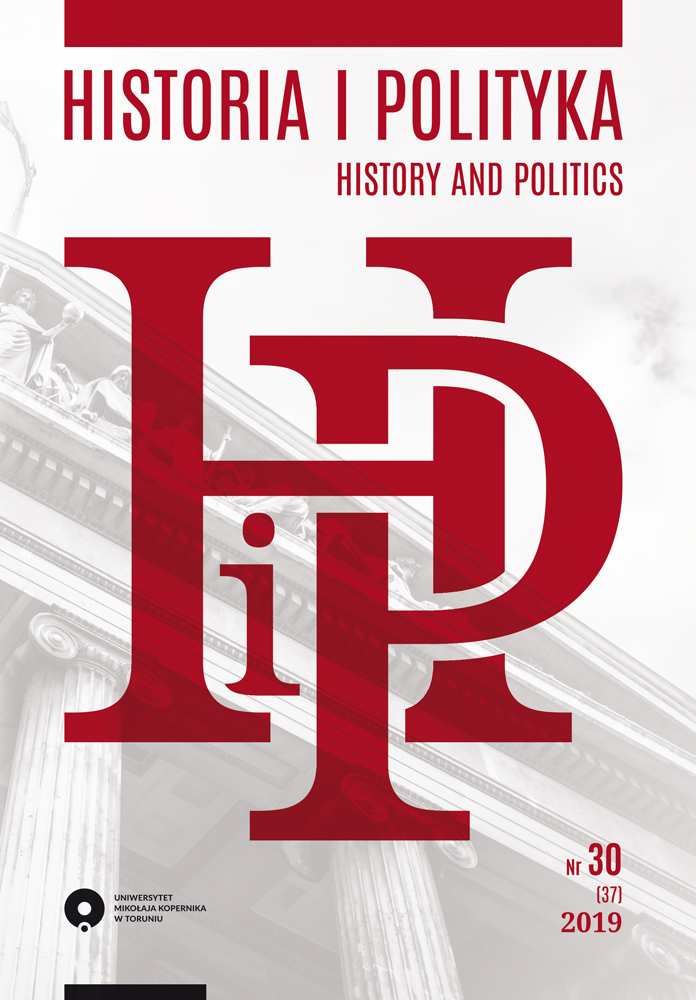Historical Narrative and Tradition as Instruments of Creating the Image of the State on the International Arena: The Case of Kazakhstan
DOI:
https://doi.org/10.12775/HiP.2019.035Keywords
politics of memory, Central Asia, Kazakhstan, nation brandingAbstract
The article aims to explain the relationships between the official historical narrative (politics of memory) and the image of the state on the international area (nation branding). The analysis was based mainly on the Kazakh cinematography and the Kazakh TV station programs.
I argue that the official historical narrative may contribute to the change of Kazakhstan perception on the international area. Politics of memory aims at highlighting the selected historical periods and concealing others. Kazakhstan elites are trying to emphasize the recent history, modernization and economic successes of the state after 1991. The pre-Soviet history is also strongly accentuated, and the historical continuity of the Kazakh nation (or even its statehood) from the end of the 15th century is highlighted. The politics of memory also aims at retraditionalization, i.e., the traditional lifestyle of nomads is widely publicized. On the other hand, the period of Russian and Soviet rule, painful events in the history of the twentieth century, are omitted or even concealed. Such a manner of conducting politics of memory may change the image of Kazakhstan, from the post–Soviet state to a modern one, modernized but at the same time nomadic, with a rich tradition.
References
Abashin, S. (2012). Nation-Construction in Post-Soviet Central Asia. In: M. Bassin & C. Kelly (eds.), Soviet and Post-Soviet Identities (pp. 150–168). Cambridge: Cambridge University Press. DOI: https://doi.org/10.1017/CBO9780511894732.012.
Abdrashev, R. (2017). The Kazakh Khanate: The Diamond Sword. Kazakhfilm Studios.
Abikeyeva, G. (2006). Natsiostroitel’stvo v Kazakhstane i drugikh stranakh Tsentral’noy Azii, i kak etot protsess otrazhayet·sya v kinematografe. Almaty: CCAK.
Anholt, S. (2007). Competitive Identity: The New Brand Management for Nations, Cities and Regions. New York: Palgrave Macmillan.
Bekentayeva, M. (2013). Kazakhstan’s Best Falconers Compete in National Championship. March 13. Retrieved from: https://astanatimes.com/2013/03/kazakhstans-best-falconers-compete-in-national-championship/.
Bloom Consulting (2017). The Digital Country Index’17. Retrieved from: https://www.digitalcountryindex.com/country-index-results.
Bodrov, S. (2008). Czyngis-Chan. Kazakhfilm Studios.
Bodrov, S., & Passer, I. (2005). Nomad. Kazakhfilm Studios.
Frigerio, A. (2017). “Something-Stan”: The Stereotypical Representation of Kazakhstan in International Movies vs. the Official Nation-Branding of the Kazakh Government. International Scientific Journal Theoretical & Applied Science, 46(2), 106–115. DOI: https://doi.org/10.15863/TAS.2017.02.46.20.
Galiev, A. (2015). Natsional’nyye istorii Kazakhstana i ikh konfliktogennyy potentsial. In: A. Owczinnikow (ed.), Konfliktogennyy potentsial natsional'nykh istoriy (pp. 135–149). Kazan: Uniwersum.
Hahn, H.H. (2008). Pamięć zbiorowa – przedmiot polityki historycznej. In: B. Korzeniewski (ed.), Narodowe i europejskie aspekty polityki historycznej (pp. 29–42). Poznań: Instytut Zachodni.
Hobsbawm, E. (2012). Introduction: Inventing Traditions. In: E. Hobsbawm & T. Ranger (eds.), The Invention of Tradition (pp. 1–14). Cambridge–New York: Cambridge University Press.
Insebayeva, S. (2017). Imagining the Nation: Identity, Nation Building, and Foreign Policy in Kazakhstan. In: M. Laruelle (ed.), Kazakhstan: Nation-Branding, Economic Trials, and Cultural Change. Washington, D.C.: The George Washington University.
Isaacs, R. (2015). Nomads, Warriors and Bureaucrats: Nation-Building and Film in Post-Soviet Kazakhstan. Nationalities Papers, 43(3), 399–416. DOI: https://doi.org/10.1080/00905992.2013.870986.
Kalymbetov, B. (2003). Sardar. Kazakhfilm Studios.
Kazakh TV (2018). Retrieved from: http://kazakh-tv.kz/ru/category/programms.
Kącka, K. (2015). Polityka historyczna: kreatorzy, narzędzia, mechanizmy działania – przykład Polski. In: K. Kącka, J. Piechowiak-Lamparska, & A. Ratke-Majewska (eds.), Narracje pamięci: między polityką a historią (pp. 59–80). Toruń: Wydawnictwo Naukowe Uniwersytetu Mikołaja Kopernika.
Kudaibergenova, D.T. (2014). National Identity Formation in Post-Soviet Central Asia: The Soviet Legacy, Primordialism, and Patterns of Ideological Development since 1991. In: S. Akyildiz, & R. Carlson (eds.), Social and Cultural Change in Central Asia: The Soviet Legacy (pp. 160–173). London–New York: Routledge.
Laruelle, M. (2008). Russian Eurasianism: An Ideology of Empire. Washington, DC: Woodrow Wilson Center Press.
Laruelle, M. (2015). In Search of Kazakhness: The Televisual Landscape and Screening of Nation in Kazakhstan. Demokratizatsiya: The Journal of Post-Soviet Democratization, 23(3), 321–340.
Lillis, J. (2011). Kazakhstan: Astana Harnesses Soft Power of Silver Screen. June 8. Retrieved from: https://eurasianet.org/kazakhstan-astana-harnesses-soft-power-of-silver-screen.
Lillis, J. (2015). Kazakhstan: Statehood Celebrations Remind Citizens Who’s Boss. October 13. Retrieved from: https://eurasianet.org/s/kazakhstan-statehood-celebrations-remind-citizens-whos-boss.
Lillis, J. (2016). Kazakhstan: TV Epic Promises Game of Thrones-Style Thrills. January 25. Retrieved from: https://eurasianet.org/kazakhstan-tv-epic-promises-game-of-thrones-style-thrills.
Marat, E. (2009). Nation Branding in Central Asia: A New Campaign to Present Ideas about the State and the Nation. Europe-Asia Studies, 61(7), 1123–1136. DOI: https://doi.org/10.1080/09668130903068657.
Narymbetov, S. (2008). Mustafa Shokay. Kazakhfilm Studios.
Nazarbayev, N. (2010). V serdce Evrazii. Almaty: Zhibek Zholy.
Nijakowski, L. (2008). Polska polityka pamięci: esej socjologiczny. Warszawa: Wydawnictwa Akademickie i Profesjonalne.
Norris, S.M. (2012). Nomadic Nationhood: Cinema, Nationhood, and Remembrance in Post-Soviet Kazakhstan. Ab Imperio, 2, 378–402. DOI: https://doi.org/10.1353/imp.2012.0072.
Omelicheva, M. (2014). Eye on the International Image: Turkmenistan’s Nation Branding. In: M. Omelicheva (ed.), Nationalism and Identity Construction in Central Asia: Dimensions, Dynamics, and Directions (pp. 91–110). London: Lexington Press.
Ponczek, E. (2015). Polityka historyczna w Polsce – od oglądu retrospektywnego do refleksji o następstwach przyszłościowych. In: K. Kącka, J. Piechowiak-Lamparska, & A. Ratke-Majewska (eds.), Narracje pamięci: między polityką a historią (pp. 29–58). Toruń: Wydawnictwo Naukowe Uniwersytetu Mikołaja Kopernika.
Reputation Institute (2018). The World’s Most Reputable Countries. Retrieved from: https://www.reputationinstitute.com/sites/default/files/pdfs/2018-Country-RepTrak.pdf.
Satayev, A. (2012). Zhauzhürek myng bala. Kazakhfilm Studios.
Saunders, R.A. (2008). Buying into Brand Borat: Kazakhstan’s Cautious Embrace of Its Unwanted “Son”. Slavic Review, 67(1), 63–80. DOI: https://doi.org/10.2307/27652767.
Stern, D.L. (2008). A Wandering Kazakh, Before Borat (Kazakhs Respond to Oscar Nomination of “Mongol”). The New York Times. February 24. Retrieved from: https://www.nytimes.com/2008/02/24/weekinreview/24stern.html.
The First World “Kokpar” Championship (2017). Retrieved from: http://www.expo2017culture.kz/en/event/view?id=356.
Włodek, L. (2016). Osiadły Tadżyk vs. Koczowniczy Uzbek, osiadłość jako wartość w tadżyckiej ideologii narodowej. Studia Migracyjne – Przegląd Polonijny, 42(4), 57–75.
World Nomad Games 2018 (n.d.). Retrieved from: http://worldnomadgames.com/en/.
Yessenova, S. (2011). Nomad for Export, Not for Domestic Consumption: Kazakhstan’s Arrested Endeavour to “Put the Country on the Map”. Studies in Russian and Soviet Cinema, 5(2), 181–203. DOI: https://doi.org/10.1386/srsc.5.2.181_1.
Downloads
Published
How to Cite
Issue
Section
License
Nicolaus Copernicus University fully respects the right to privacy and protection of personal data of all authors. The authors’ personal data is not used for commercial and/or marketing purposes.Stats
Number of views and downloads: 798
Number of citations: 0



